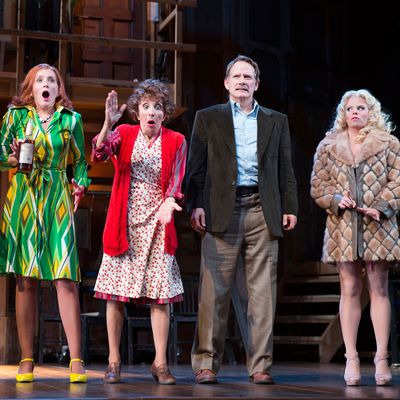
The key thing about farce isn’t the slamming of doors but the solidity of walls; without rigid order there can be no liberating chaos. The carpentry is crucial, and I doubt there’s ever been a better-carpentered example of the genre than Michael Frayn’s Noises Off, now in a cry-your-eyes-out funny revival at the Roundabout. So precise is the play’s construction, both in terms of physics and metaphysics, that it seems to have been written with a magic wand and a nail gun. Watching it, helpless with laughter for long stretches, I was too distracted to think much about the work that went into it, but later, reading the script, which is more like an engineering blueprint for a nuclear device, I began to wonder if it wasn’t among the best-built things, farce or not, ever put on a stage, including even Megan Hilty in a pink push-up teddy.
What she’s doing in that teddy is, of course, a long story, but describing the plot is a daunting and perhaps pointless task. That’s because Frayn has squared the energy of regular farce by setting Noises Off during rehearsals and performances of another farce, this one called Nothing On. Nothing On is silly and smarmy in the traditional English manner, involving married tax exiles returning secretly to their country home after months in Spain, a Realtor showing their home to the bimbo revenuer he hopes to bed there, a partly deaf burglar in horizontal stripes, and the dotty housekeeper who just wants to enjoy her plate of sardines. In Act One of Noises Off we see this twaddle being rehearsed by its bilious director and a company of actors with their own farcical leanings: one a drunk, one blind without her contact lenses, one who faints at the sight of blood, and so on. But Act One, funny as it is, is just the exposition for Act Two, which takes place a month later. Nothing On is now playing perhaps the third or fourth leg of its tour of the provinces; we watch, this time from behind — the set has revolved to reveal all the tricks that make a farce go — as the offstage conflicts seep into and nearly explode the onstage production. (Needless to say, those offstage conflicts, which now involve the exhausted stage manager and his lovelorn assistant, are every bit as ridiculous as the onstage ones.) By Act Three, two months and several intra-cast feuds further into the hobbled run, there is little left of Nothing On. The set has revolved once again so we see it from the front, but everyone is lost in the world between two unrealities.
What this requires of the actors is extraordinary. To begin with the play is, by all accounts, a monster to memorize, with its theme-and-variations structure, its two-part roles with their onstage-offstage differentiations, and its precipitous disintegration. Then there are the physical demands; the performance is a workout and an obstacle course. (David Furr, as the Realtor and as the nimwit who plays him, has a spectacular pratfall that almost literally brings down the house.) Counterintuitively, the acting of farce must be more disciplined than in more profound forms of theater, not only because a misstep might break someone’s face but because consistency and clarity of motivation are necessary to create the extreme conditions from which the lunacy arises. This cast — including, in the “inner” play, the superb Furr and Hilty and also Andrea Martin, Jeremy Shamos, Daniel Davis, and Kate Jennings Grant — is so well-matched, as some previous casts have not been, that under the direction of Jeremy Herrin they really do seem to have been working together for months. And if I was not as impressed with the additional “outer” play characters, that’s mostly because they are there to set up the others. It’s hard to play a fuse.
Physically, the production is ideal. Derek McLane’s set is, naturally, the star, responsible for telling much of the story. (The doors never fail except when they’re meant to, and then they do it perfectly.) Michael Krass’s costumes instantly conjure the monstrous tackiness of ’70s British sex comedies in just the way Todd Almond’s original music sours before your ears like sitcom bumpers; Jane Cox’s lights, neatly differentiating the different worlds of the play, run the gamut from glum to garish. Yet all this extreme theatricality is in the service of reality: a reality that, as Frayn sees it, is at least as extreme as what we ever see on stage.
Indeed, the astonishing thing about the contrivances is that, in a well-judged production like this one, they eventually break into yet another sphere. In that odd meta-theatrical hyperspace we are no longer even sure what we’re laughing at. We may also briefly feel the farce bending into something more profound: a demonstration of and thus a meditation on randomness. (Another of Frayn’s plays, Copenhagen, is about the physicists Niels Bohr and Werner Heisenberg.) And certainly we become aware of a kind of abstract poetry as the linguistic glue of the rational plotting dissolves; you would be unlikely to find, except in Mallarmé or Rimbaud, such hilariously surreal lines as “I put presents from Sardinia in the pigeonhouse” or “Good job I can’t see far with this leg” or “I thought I heard a box.” How something can be, like these utterances, both nonsense and (in the context of the play) inevitable is a great and beautiful mystery, one that makes Noises Off not just one of the funniest plays ever written but one of the best. It just keeps unfolding. If satire is famously what closes on Saturday night, farce, at this level, is what closes (and opens and closes and opens) ad infinitum.
Noises Off is at the American Airlines Theatre through March 6.

